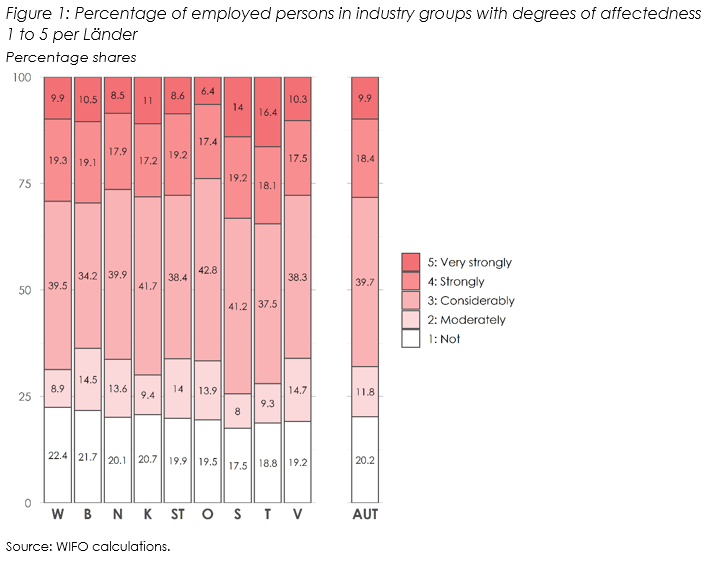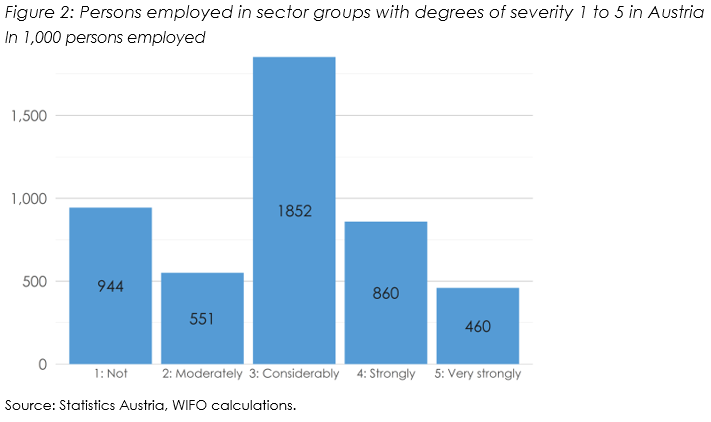
Corona Crisis: Regional Differences in the Economic Vulnerability
Against the background of the massive economic impact of the COVID-19 pandemic and the measures taken to contain it, this paper presents an assessment of the relative impact of the economy of the Austrian Länder in the current crisis phase. The analysis is based on a scale recently developed by the Austrian Institute of Economic Research (WIFO) on the extent to which individual sectors of the economy have been affected by the measures taken to contain the spread of COVID-19, and a transfer of this scale to the sectoral structure of the individual Länder.
The classification of the 88 NACE two-digit industry divisions (national classification of economic activities) according to their economic impact is based on a five-level scale from "not affected" (1) to "very strongly affected" (5). Sector groups are defined as "severely (very severely) affected" if they are currently unable to operate or can only operate to a very limited extent due to the measures taken and if it is (not) likely that they will be able to make up for the business they have lost at a later date. In addition, the classification is based on demand-side restrictions due to declines in exports or in the consumption behaviour of private households and/or supply-side restrictions due to production disruptions caused by the interruption or delay of supply chains. The results of the assessment (in detail and summarised for more aggregated economic sectors) as well as the criteria applied to classify the economic impact of the sectors can be found in the Working Paper "Regional differences in the economic impact of the current COVID-19 crisis in Austria – A structural approach at the level of the federal provinces".
On the basis of the developed industry typology and the industry structure of the respective Länder it can be shown to which extent the individual Länder are affected by the current COVID-19 crisis. Figure 1 shows the respective employment shares in the differently affected branch groups for the individual Länder and for Austria as a whole, and thus provides information about the relative affectedness of the Länder. It also shows the absolute numbers of employees in the variously affected industry groups in Austria.
In total, about one third of the persons employed in Austria work in sectors which, according to our assessment criteria, are not economically affected or only moderately affected by the current crisis phase. Conversely, severely to very severely affected industry groups, i.e. those that are currently unable to carry out their business activities due to the measures taken, account for 28.2 percent of the Austrian workforce. This means that in the whole of Austria, about 1,320,000 persons employed can be attributed to industries that have been strongly and very strongly affected.


Upper Austria (23.8 percent) and Lower Austria (26.4 percent) have the lowest share of employed persons among the Länder in industries that are strongly or very strongly affected. Tyrol (34.4 percent) and Salzburg (33.2 percent) have by far the highest share of employees in industries that are economically strongly or very strongly affected by the current COVID-19 crisis. Decisive for the ranking of the Länder at both ends of the scale are the regional importance of the only moderately to considerably affected (but employment-strong) manufacturing, and that of the retail as well as tourism and leisure industry (accommodation and catering or culture and entertainment) with its particularly high degree of affectedness.
Despite considerable differences in regional economic structures, most countries are similarly affected. The advantages and disadvantages of specialisation in economic sectors that have been affected to varying degrees therefore largely cancel each other out. For this reason and given the overall high degree of economic affectedness in all Länder – 68 percent of the working population in Austria work in sectors that are currently severely to very severely affected – horizontal measures with a broad sectoral impact appear to be a priority at the present time. In their implementation, however, such measures will have to be adapted to the respective regional context in order to achieve an optimal effect.
























